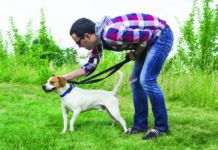One way to get your dog to wait is to cue him to “Sit,” which is the very first word many dogs are taught. But what if you want him to wait and he’s not right next to you? What if he has run ahead on a trail to catch up with a skunk or a coyote? Or what if he has ended up across a busy road from you and you don’t want him to attempt to cross back over by himself? Or there’s too much traffic whizzing by for him to even hear you? In such cases, “Sit” probably won’t work because he associates it with being right next to you and getting a treat, or at least a nice stroke on the muzzle for complying.
For reasons such as those, it’s a good idea to bring “Wait” into your training arsenal, accompanied by a hand signal so that your dog will comply even if he can’t hear you but can still see you. There are four steps to teaching your dog the cue, as there are to most basic training cues.
Step one is usually to say the word you want your dog to learn, but with this particular cue it’s more important to use a hand signal since the whole point is being able to get your dog to attend to your wishes even when he can’t hear you. Start by flashing your hand very quickly in front of your dog’s face. Another option for teaching “Wait” is to quickly point a finger at him. It doesn’t matter what body language you use, as long as you don’t use it regularly in other activities so your dog won’t get confused.
Even though the hand signal is key here, you can go ahead and say the word “Wait” at the same time. It won’t hurt your pet to learn the cue both by sight and by sound. Start with your pet very close by, indoors — no more than a couple of feet away.
Step 2 is the hardest part of any training because it’s the one where you don’t do anything but simply wait for your dog to comply. You have to take a leap of faith. To help things along, keep a firm (not stern) facial expression and a readiness in your body language rather than a stance that is completely relaxed. Never yell. Patience is key.
Step 3 is the “Voilà” part of training. Your dog actually waits rather than moves toward you when you use this strange new body language and strange new word.
Step 4. This is the gratifying part, both for your dog and you. You get to walk over to him and reward him for complying. When he is first learning the trick, especially a difficult one like “Wait,” the reward should be in the form of a delicious morsel of food that he rarely gets, such as a tiny piece of beef. You should also reward him by praising him warmly and stroking him on the muzzle or wherever he likes it.
Take it outside
You should only train a new cue for a few minutes each day. Your dog will lose interest if you keep making him do the same thing over and over. But as you train, increase the distance between you and your dog so the cue will work when you really need it to. First put more distance between you and him right in the house. Then teach him the trick in a fenced-in yard or park, where there will be more distractions but he can’t get too far. Then try it in a park where dogs are allowed to romp off-leash, first from close by and then from a considerable distance. Keep the treats coming. When you see he has gotten the hang of it, you will be able to feel much more confident that you can keep him safe when you need to — or that you will be able to catch up with him if the two of you are walking outside and he has gotten way ahead.
Going forward, employ the “Wait” cue every so often even if it’s not necessary, with a treat here and there. Like words in any foreign language, it has to be used periodically in order not to be forgotten.





